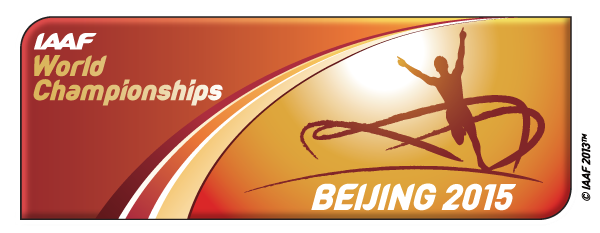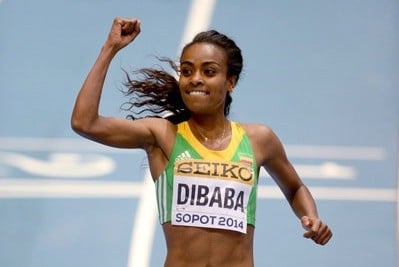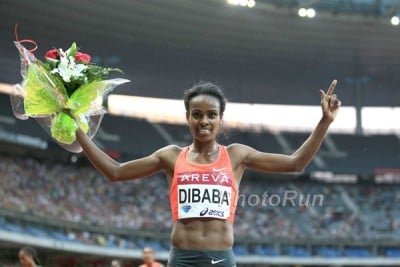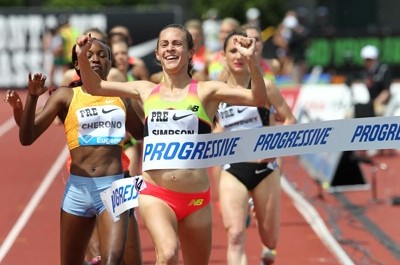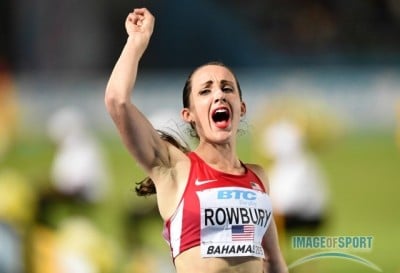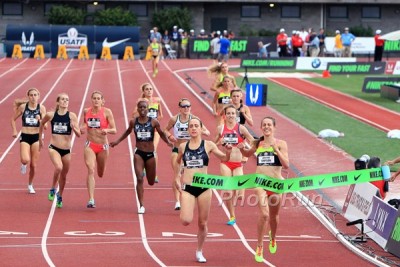2015 Worlds Women’s 1500 Preview – “On paper, this isn’t a race; it’s a coronation.” – Can Americans Jenny Simpson and Shannon Rowbury somehow take down Genzebe Dibaba?
by LetsRun.com
August 18, 2015
What a race. This race has it all.
The returning champ.
The European champ who has run 3:56.05.
Two historically fast Americans.
And, oh yeah, the world record holder.
| 2013 World Champs top five 1. Abeba Aregawi, Sweden 4:02.67 2. Jenny Simpson, USA 4:02.99 4. Hannah England, Great Britain 4:04.98 2015 five fastest performers (among women entered) |
The women’s 1500 at this year’s IAAF World Championships in Beijing is one of the most intriguing races of the meet, and though Abeba Aregawi, Sifan Hassan, Shannon Rowbury and Jenny Simpson deserve their dues, Genzebe Dibaba is the woman who will dominate the headlines and rightly so. A little over a month ago, Dibaba seemed locked into running only the 5,000 at the World Championships. No one was thinking about 3:54, yet alone 3:50.07 and a world record.
Dibaba’s 3:54.11 in Barcelona on July 8 and her unthinkable 3:50.07 world record in Monaco nine days later turned the 1500 on its head, and she enters Beijing as the heavy favorite. That’s what happens when you’ve run over five seconds faster than anyone else in the past 18 years.
In fact, since the women’s 1500 became an Olympic event in 1972, no athlete has entered a global championship with a bigger margin on the world list than Dibaba in 2015. Check out the table below.
Biggest margin from 1st to 2nd performer on world list heading into Worlds/Olympics
| Year | World Leader (Pre-Champs) | Margin | Champs result |
| 2015 | Genzebe Dibaba | 5.98 | ??? |
| 1997 | Kelly Holmes | 5.35 | DNF, 1st rd. (Achilles injury) |
| 2003 | Sureyya Ayhan-Kop | 3.98 | 2nd |
| 1976 | Tatyana Kazankina | 3.80 | 1st |
| 1995 | Sonia O’Sullivan | 2.99 | 1st in 5k (did not run 1500) |
| 2004 | Elvan Abeylegesse | 2.87 | 8th |
| 1988 | Paula Ivan | 2.70 | 1st |
| 2009 | Maryam Yusuf Jamal | 2.24 | 1st |
| 1983 | Mary Decker Slaney | 2.19 | 1st |
While there are drug questions about multiple women on that list (Ayhan-Kop was banned for life in 2009; Kazankina served an 18-month ban for failing to take a drug test in 1984 and the IAAF gave Decker Slaney a two-year ban in 1997), that’s not massively important given that they all still ran at a championship that year. And, as you’d expect, the numbers suggest that running a lot faster than your competition is generally a good thing. Five of the eight women on the list won gold (albeit at 5,000 for O’Sullivan) and one more won silver. And though we can’t hand Kelly Holmes the gold in 1997 (that’s the whole point of running through this analysis), it seems inevitable that she would have won Worlds had an Achilles injury not caused her to DNF in the prelims. She had won all eight of her races in 1997 and was the massive favorite.
Time isn’t everything in the 1500 — you need only look to 2011, when Jenny Simpson won Worlds with a season’s best of 4:03.54. But it obviously helps to run fast. 2013 world champ Abeba Aregawi had the #1 time going into Worlds; former 2012 Olympic champ Asli Cakir Alptekin (who was stripped of her gold medal on Monday for a doping violation) had the #2 pre-Olympic time. In every event, even one as tactical as the 1500, there’s a certain point where raw ability — as shown by Dibaba’s ridiculous PR — overwhelms all.
And in the women’s 1500 right now, that point is somewhere in the 3:52 range. On paper, no one should be able to touch Dibaba. It’s not just her 3:50.07; it’s that theoretically she should be favored in any style of race. She closed her world record in 2:01.8 for the final 800; that suggests she’d be capable of well under 2:00 in an open 800, which no one else in this field could match. On the other end of the spectrum, her 5,000 PB of 14:15.41 is fourth-best all-time and over 16 seconds faster than anyone else in the field. If Dibaba wants to run from the front, she is so far ahead of everyone else (watch that Monaco race again) that she should be able to drop them, even without a rabbit.
If she wants to kick, Dibaba has the best speed of anyone. She closed her world record in Monaco with a 59.8-second final lap. That kick would win most Diamond League meets, which are typically won around 4:00; considering she ran the first three laps at 3:52 pace, you’d figure Dibaba could summon something in the 57-58 range off a slower pace. The table below shows how Dibaba’s close in Monaco stacks up to the final laps of the last three world champions.
| Year | Winner | Winning time | Final lap |
| 2015 | Genzebe Dibaba | 3:50.07 | 59.8 |
| 2013 | Abeba Aregawi | 4:02.67 | 58.9 |
| 2012 | Asli Cakir Alptekin | 4:10.23 | 58.0 |
| 2011 | Jenny Simpson | 4:05.40 | 60.8 |
Why It’s Not That Simple
On paper, this isn’t a race; it’s a coronation. And make no mistake, Dibaba is most definitely the favorite. But contrary to popular belief, she’s not invincible and she can be beaten. Though she is undefeated this year, Dibaba lost no less than six times in 2014, including her only 1500 (second to Simpson in Stockholm).
Dibaba won the World Indoor 3,000 last year in a romp; two years earlier, she did the same thing in the 1500. But her track record in outdoor championships is poor. In 2009, at age 18, she was eighth in the 5,000. Two years later in Daegu, she was eighth again in the same race. Those two performances are understandable. She was young and had not yet reached her current level of fitness.
The next two are harder to explain away. In 2012, she entered the Olympics as the World Indoor champ; her 3:57.77 was the #3 seed time. She finished 10th in her 1500 heat and didn’t even qualify for the semis. The next year, in Moscow, Dibaba again entered with the #3 time in the world (3:57.54). This time, she made the final, but was only eighth overall.
Some have argued that Dibaba, who always runs well indoors and in ’12 and ’13 ran her SBs on May 10 and May 19, respectively, peaks too early. Dibaba’s coach, Jama Aden, has a different theory. He explained that her previous struggles at Worlds/Olympics outdoors are the result of Dibaba being forced to attend the Ethiopian pre-championships training camp.
“I think it’s not about peaking,” Aden told LetsRun in March. “She probably would have been the winner in the 1500 in Moscow but they have to hold a camp with the [Ethiopian] national team and she has to train with the national team. It wasn’t my program.”
This year Dibaba wasn’t forced to attend the training camp and thus will be on Aden’s program leading into Worlds. And her season to this point — with massive outdoor PRs at 1500 (3:57.54 to 3:50.07) and 5,000 (14:28.88 to 14:15.41) — has shown no signs of slowing down. But the questions will linger until Dibaba gets it done at an outdoor championship. Has she simply substituted a much-too-early-peak (indoors) for an early peak (July)? Will those hard efforts chasing time come back to bite her in Beijing? Maybe. But when you’re using excuses like “she ran too fast,” to explain why someone can’t win a race, it usually means they don’t have many flaws.
The talk about Dibaba this year reminds us a bit of the talk about Rudisha prior to 2011 Worlds. The next two years went quite well for Rudisha in 2011 and 2012.
The other question mark about Dibaba is whether she can make it through three rounds in four days and still overpower everyone in the final (she’s also entered in the 5,000, but the prelims don’t start until after the 1500 final)? Making the final shouldn’t be hard considering how much faster she is than everyone else, but it will require some effort, particularly with the heats and semis falling on back-to-back days. It’s not easy to lead an entire race from the front, and it’s harder to do it when it’s your third race in four days. And though that strategy could still work, it carries a risk. If Dibaba is off her game and one of her rivals — Hassan, Rowbury, Simpson, Kipyegon — times her peak exactly right, the gap between them narrows. The best-case scenario for Dibaba’s would-be rivals is a race similar to last year’s Stockholm Diamond League meet, where Dibaba tried to push the pace early but faded over the final laps as Simpson ran her down in the home straight. In Monaco, Hassan was 5.98 seconds behind Dibaba but much of that gap came in the final 200 as Hassan cratered after staying right behind Dibaba for 1100 meters.
If Dibaba runs a more conventional race, allowing the 1500 final to go slow, she would still be favored, but it’s not a slam dunk that she would win. The slower a race goes, the more important positioning becomes, and if there’s skill that could hurt Dibaba, it’s positioning. Most of her races go so quickly that Dibaba never has to worry about running anywhere other than the inside of lane 1. Even her championship victories at World Indoors were by massive margins (2.00 seconds in the 1500 in ’12; 2.68 in the 3,000 in ’14). Someone like Simpson works all year at perfecting her tactics; she essentially used the 1500 final at USAs to test herself in a new race situation.
Just watch how much extra distance Dibaba runs in the 2013 Worlds 1500 final, and pay attention to her hard (but ultimately pointless) move at 600 meters. By the time it comes time to kick, Dibaba has nothing. Aregawi and Simpson were on a different level that day, but perhaps a smarter race would have put Dibaba in the medal hunt.
There’s also a difference between raw speed (the kind that allowed Dibaba to close her WR in 59.8) and the acceleration necessary to win a 1500 in the final 100 meters if it’s still close. As Renato Canova says in How to Race the Mile by Jeff Hollobaugh, “In many cases, athletes get confused between ‘speed for the kick’ and ‘high speed endurance’…[Silas Kiplagat] is able to finish the last 300m in 39.5 during a 3:27 race, but he cannot finish faster while running a 3:39. Why? Because he is an ‘aerobic runner,’ with great relaxation and elasticity, but not the technical action (and the nervous system) valid for a quick and sudden change of speed.”
Dibaba, certainly fits that description as she comes to the 1500 from an aerobic background. She explained prior to Monaco that she’s actually worked less on speed this year than in the past as she felt she had great natural speed; instead, her training has been geared toward the 5,000. But even though her superior fitness affords her a cushion over the field, she still has to get her tactics right. Go hard from the gun and she risks being run down at the end of the race. Go too late and she wastes her biggest advantage. Dibaba has to find the perfect moment to move between those two extremes, and it will be fascinating to watch what she decides to do. In an event such as this, everything is dictated by the favorite’s strategy. How Dibaba decides to play it will determine the story of this race.
If we were Dibaba, we’d run relaxed on the outside for 500 meters (at at least 64 pace) and then slowly squeeze it down all the way to the finish.
The Challengers
So who could beat Dibaba? There are a handful of women who could do it if everything goes right. Top of the list has to be the Netherlands’ Ethiopian-born Sifan Hassan. In her last three races, Hassan has run a PB at 1500 (3:56.05) and 800 (1:59.46) and another fast 1500 (3:56.33 in a mixed race on August 12 in a race she supposedly asked to be paced to 3:52). Her last three 1500s also suggest that she’s clearly #2 in the world right now. Most recently, there was that 3:56.33. Before that, in Monaco on July 17, she was the only one brave enough to go with Dibaba, and though she died over the final lap, she still held on for a 3:56.05, the fastest non-Dibaba time in nine years. In Lausanne on July 9, with no Dibaba in the field, Hassan dominated, pulling away to win by over a second against a top-notch field including Simpson, Kipyegon and Dawit Seyaum.
There are two knocks on Hassan. First, she’s 22 and has never raced at a Worlds/Olympics; second, she faded in the final two Diamond League 1500s last year after dominating in June and July. The first is a concern, but Hassan won European titles indoors (in 2015) and outdoors (in 2014); she was also fifth at World Indoors last year, so she has some experience. The second point could be evidence that Hassan wasn’t able to hold her form through the end of the season. But you could also argue her biggest meet last season was the European Championships (which she won handily over Aregawi). And after the DL 1500 final in Zurich on August 28, she bounced back the next week to finish second in the Brussels 3,000, beating Dibaba, Simpson and Rowbury in the process. Considering she just ran 3:56 again in the second week of August, she should be fine by the Worlds final on August 25.
Up until July, we’d have given Simpson the edge over Hassan, but the Dutchwoman has been too good since then to ignore. Simpson still has a great shot at a medal, however. This year, she’s won 1500s at the Pre Classic, Rome and the U.S. Champs, and though she was only fourth in Monaco, she still ran just 3:57.30 — just .08 off her PR — despite leading the chase pack for the majority of the race. In three of the past four years (2012 excluded), Simpson has timed her peak perfectly, and she has the strength, closing speed and championship experience to be a major factor at Worlds. Plus Simpson could pick up the silver in Hassan goes for broke and tries to run with Dibaba.
Of course, there’s another American medal threat and her name is Shannon Rowbury, and she, not Simpson is the current American record holder. Simpson had dominated their rivalry in recent years, winning 10 straight encounters before Rowbury’s shocking 3:56.29 American record in Monaco. And while Simpson still deserves the edge heading into Beijing (if the roles were reversed in Monaco, with Rowbury leading the outcome may have been different) based on that dominance, Rowbury is very, very good and could absolutely beat Simpson out for a medal. It’s even possible that the Americans could take home two medals in the same event, something that’s never happened in a race longer than 400 meters at the World Championships — male or female.
The case for Rowbury over Simpson is built on more than just that American record in Monaco, where Rowbury finished over a second ahead of her rival. At USAs, Rowbury tore up her foot in her prelim (she ran with one shoe for the final 650 meters) and had to run with it bandaged up in the final. She wound up losing to Simpson by just .13. And though Simpson beat Rowbury convincingly at Pre, it needs to be remembered that was before USAs. Plus Rowbury has been on fire all year long. Take away her single-day doubles, and it’s hard to find a bad race — perhaps her 2:03.53 800 in Lausanne? Rowbury’s indoor season was historically great, with a 4:22.66 mile (on a flat track), the fastest in the world in 15 years, and victories in the mile and 2-mile at USA Indoors. Only a few women can hope to hang with Simpson at her best, but Rowbury is one of them.
There are a few other women capable of a medal. Kenya’s Faith Kipyegon has only run 4:00.94 this year, in part because she’s taken a while to come back to the 1500 after suffering a foot injury over the winter. But she has a fast PR (3:56.98 at age 19 in 2013) and great strength (14:31 5,000 at Pre). The third returner from Moscow, Kipyegon finished second (ahead of Simpson) in Lausanne and won the Kenyan Trials on August 1. A former World Youth and World Junior champ, the 21-year-old Kipyegon is a major talent.
Another young gun to watch is 19-year-old World Junior champ Dawit Seyaum of Ethiopia. Seyaum beat Hassan to win the DL opener in Doha on May 15 and was third in Rome and Oslo before fading to 11th in Lausanne. She may still be a year or two away from medaling, but she will be one to watch in Beijing.
Finally, there’s Great Britain’s Laura Muir. Muir may not be a big name outside of Britain, but the 22-year-old has quietly developed into a very formidable runner and is a serious medal threat. After her 3:58.66 in Monaco, only double Olympic champ Kelly Holmes has run faster among Brits, and she made history by becoming the first Brit (male or female) to win a DL 1500 with her front-running effort in Oslo on June 11. If there’s a knock on Muir, it’s that she’s struggled in championships in the past. Here’s her championship record over the past three years:
| Year | Championship | Event | Time | Place |
| 2015 | Euro indoors | 3000 | 8:52.44 | 4th |
| 2014 | Euro outdoors | 1500 | 4:14.69 | 6th (heats) |
| 2014 | Commonwealth Games | 1500 | 4:14.21 | 11th |
| 2014 | World indoors | 800 | 2:02.55 | 2nd (heats) |
| 2013 | World outdoors | 800 | 2:00.83 | 7th (semis) |
| 2013 | Euro U-23s | 1500 | 4:08.19 | 3rd |
| 2013 | Euro indoors | 1500 | 4:18.39 | 8th |
There’s reason to believe Beijing will be different, however. First, Muir has reached a new level this year outdoors, running PRs in the 800 (2:00.42), 1500 (3:58.66) and 3000 (8:38.47). Second, it can take some time for a young runner to figure things out at championship events. Muir’s previous results aren’t all that bad for a 20/21-year-old. She’s banked that experience, and now that she’s developed as a runner, she should be in position to start capitalizing on it. The women’s 1500 is a stacked event right now, so a medal may not come this year, but a good showing in Beijing could propel her to success in 2016 and beyond.
We should also mention defending world indoor/outdoor champ Abeba Aregawi of Sweden, who enters as the wild-card to watch in 2015. Given her 2015 form, she seems unlikely to medal this year as she’s finished 7th, 2nd and 4th in her four Diamond League races this year, with a best of 4:01.97. However she’s just 25 and those results all are from early in the year (she hasn’t raced since June 11th, she withdrew from Monaco in the middle of July). It would be foolish to totally ignore a woman who racked up 11 Diamond League wins and two world titles between 2012 and 2014. The Swedish coach says he’s feeling good about her chances as he recently said, “She really believes in this 100 per cent and I feel incredibly good vibes from (her).” So discount her at your own peril.
The Other Americans
No one expected Kerri Gallagher or Lauren Johnson to be on Team USA at the start of the year, but both have made major breakthroughs this year and took advantage of a slow race at USAs to punch their tickets. Look at the progress each has made in 2015:
Gallagher
PR at the start of the year: 4:09.64 (2013)
PR #1: 4:08.70 (USA prelims, June 26)
PR #2: 4:03.56 (Lignano, July 7)
Johnson
PR at the start of the year: 4:10.67 (2014)
PR #1: 4:10.30 (Burnaby, June 8)
PR #2: 4:07.33 (Portland, June 14)
PR #3: 4:04.17 (Heusden, July 18)
Add in Rowbury’s big PR in Monaco, and the three of them have dropped a cumulative 15.78 seconds off their 1500 times in 2015 alone!
Unlike Simpson and Rowbury, who are virtual locks, it will be a challenge for Gallagher (#25 on the world list) and Johnson (#28) to grab one of the 12 spots in the final, even though both Gallagher and Johnson PR’d in Europe this summer. Of the two, Gallagher, who would have gone to Worlds in 2013 as Treniere Moser‘s injury replacement had she run the standard, has the better shot. She beat Johnson at USAs, has run faster, and her final race in Europe went better (4:06.07 in Monaco vs. 4:12.26 in London).
Editor’s note: We have written a profile of Johnson’s amazing journey to Bejing here: The Lauren Johnson Story: From Over 2:20 for 800 in HS to The US World Championship Team at 1500.
LRC Prediction: 1. Dibaba 2. Hassan 3. Simpson
There are a couple of concerns about Dibaba, but she’s been a force of nature this year and barring a major choke, it is going to take an epic performance to bring her down. Hassan and Simpson have both been in great form, but history says when someone is this much faster, they will win the race. We’ll give Simpson the nod over Rowbury for third, making her the first woman to win a gold, silver and bronze medal in the 1500 at Worlds. A big question we have is do the women not named Dibaba play it safe and try to secure silver or battle Dibaban and possibly blow up and finish with no medal.
Race Schedule All Times US ET
Heats – Friday August 21 11:15 pm ET.
Semis – Sunday August 23 8:45 am ET
Final – Tuesday August 25 8:35 am ET
Discuss this great race on our world famous fan forum: MB: Official Women’s 1500 Discussion Thread.
